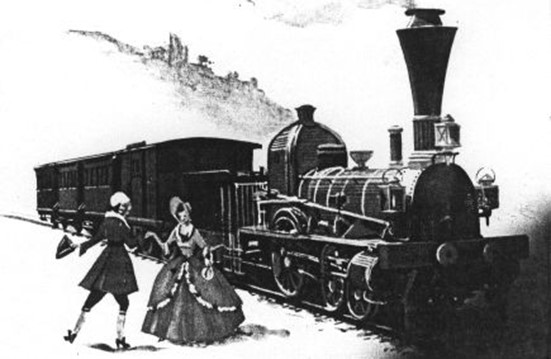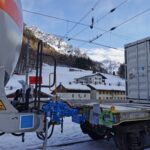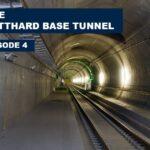In this tribute, you will learn how rail freight transport in Switzerland is moving persistently towards the future. For many years, innovation was a foreign word for the «brown wagons». But this era is passé. The freight railways are ready for the age of 4.0 and their place on the rails. This is indispensable for security of supply, environmentally friendly transport performance and relieved roads.
That’s what it’s all about:
- Continuously on the rise for 175 years
- Provides over a third of the transport services in and through Switzerland
- Looking back at past crises and successes
- A century ahead in electrification
The transport performance of rail freight in Switzerland has undergone an impressive development since the beginning of the 20th century. According to the Federal Statistical Office (FSO), it totalled about 1.5 billion tonne-kilometres in 1900. Since then, rail has been marked by many crises, some of them far away. Today it accounts for 10.4 billion tonne-kilometres. tonne-kilometres and a 37% share[1] of the modal split, it is an important pillar of the Swiss transport system. But let’s take it one step at a time.
Small country, big performance – still a lot of potential
The transport performance of rail freight has fluctuated over the decades (cf. Figure 1). Since the end of the pandemic, it has been rising steadily again. In transalpine freight transport (transit), there is a transfer obligation based on the article on the protection of the Alps in the Federal Constitution. As a result of the construction of the NRLA, the four-metre corridor and unprecedented financial support for unaccompanied combined transport (UCT), Switzerland had a very high modal split in favour of rail in transalpine transport in 2021, at 74%; the transport performance of rail freight transport was a peak value compared to other countries, at 66% of transit traffic. The overall modal split of 37% rail was also above the international level.
In non-transit traffic, there is no modal shift mandate. Enormous potential lies dormant in domestic transport (2021: 23%), imports (7.5%) and exports (3.5%[2]), provided that the fundamental modernisation and reorganisation of wagonload transport and the promotion of intramodal competition are implemented[3]. This includes the automation and digitalisation of the rail system. These put wagonload traffic in the fast lane and make rail fit for intermodal competition and multimodal logistics chains. Sufficiently available infrastructure for the freight railways and more conveniently located logistics sites further accelerate this progress[4].
Switzerland’s transport and infrastructure policy should therefore increasingly focus on the customer benefits of rail as a mode of transport for the shipping industry. The more benefits the Swiss rail freight transport system brings to shippers, the more it will be used – in other words, the more traffic will be shifted. We at the VAP reject an explicit shift of traffic.
Uphill and downhill journey with a clear gain in altitude
On 7 August 1847, the first railway line entirely on Swiss soil from Zurich to Baden – popularly known as the «Spanish-Brötli-Bahn»[5] (cf. Figure 2) – was ceremoniously opened. One of the reasons for the construction of this line: the lords of Zurich had their messengers bring them the puff pastry «Spanisch Brötli» – mainly on Sundays – from a well-known master baker in Baden. The poor servants always had to make their way to Baden on foot shortly after midnight so that they could put fresh rolls on the Sunday breakfast table. The «Spanish-Brötli-Bahn» made it possible to transport goods and people quickly and reliably.[6]
The first railways in Switzerland were built on private initiative. They were able to start operating with a concession from the cantons they served. Initially, the Confederation only specified the technical aspects. Later, the Confederation was given more powers to ensure a sensible national network.
In 1857, a railway mail coach was used for the first time in Switzerland by the Schweizerische Nordostbahn on the Zurich-Baden-Brugg line. This was the beginning of Swiss railway mail. In 1859, the route network already had a length of more than 1000 km, there was a continuous connection from Lake Constance to Geneva, to which Bern, Lucerne, Chur, St. Gallen, Schaffhausen and Basel were also connected. In 1882, after the completion of the 15-km-long summit tunnel, the Gotthard railway was able to begin operations.
In 1875, the first law for the construction and operation of industrial sidings was introduced in Switzerland, thus legally regulating the legal relationships for sidings. The referendum of 20 February 1898 marked the end of the private railway age, and from 1902 the newly founded state railway SBB took over the largest railway companies as well as smaller private railways. With nationalisation, responsibility for the further development of the railways passed to the federal government. The takeover of the infrastructure by the SBB was a good step. However, operation on the network was to be characterised by competition.
With the monopolisation of rail transport, it was time in 1912 to establish a representative for the private players. This was the birth of the VAP Verband Schweizerischer Anschlussgleise- und Privatgüterwagenbesitzer – today’s VAP Verband der verladenden Wirtschaft – which from then on campaigned for fair competition and the optimisation of economic policy conditions, rail infrastructure and logistics locations. At that time, rail made a decisive contribution to the industrial revolution – the profitable connection soon overtook ship and horse-drawn carriage as the infrastructure grew. Fast transport within Switzerland, but also to Europe, opened up new economic opportunities.
During the First World War, the transport performance of rail freight first rose, before declining by 18% in 1917 and 14% in 1918. These declines can be attributed to the interruptions in production and trade as well as the effects of the Spanish flu. The pandemic at that time affected about half of the Swiss population in two waves and claimed almost 25,000 lives between July 1918 and June 1919. Transport performance recovered in the 1920s before plummeting again in the year of the economic crisis in 1921 and with the New York stock market crash of October 1929.
With the beginning of the Second World War, the freight railway began an upswing, which it owed to the armament economy and political decisions[7]. Domestic traffic increased, as the now largely electrified railway replaced car and truck traffic, which had been largely paralysed due to a lack of fuel. During the Second World War, the transport performance of the railways declined massively until freight transit traffic almost completely collapsed at the end of the war and the transport performance lost 42% overall.
After the Second World War, the economy recovered and with it the transport performance of the railways. It reached a first record level in the 1970s. This was followed by sharp declines due to the oil price crisis, the 1987 stock market crash, the real estate crisis and the subsequent recession of the 1990s. In 1999, Switzerland launched the first of several steps of the so-called railway reform in the context of the European market opening for UCT and based on EC Directive 91/440/EEC[8]. The aim: to make the Swiss railway system more efficient and customer-friendly.
The new railway sidings law of 5 October 1990 and the ordinance of 26 February 1992 are intended to give new impetus to the promotion of rail freight transport and to help solve the numerous problems facing freight transport in a future-oriented manner.
In the year 2000, rail freight transport performance was five times greater than in 1950 (+397%). This multiple is all the more impressive given that the share of rail in total freight transport declined massively in favour of road transport precisely in those years. For despite the experience of fuel shortages during the Second World War, the transition to a petroleum-based economy took place after the end of the war.
The New Rail Link through the Alps (NRLA) brought a further boost. With three base tunnels through the Alps and the expansion of the access routes, it brought the north and south of Switzerland and Europe closer together. The Lötschberg base tunnel has been in operation since 2007. The Gotthard Base Tunnel was opened in 2016. In 2020, the NRLA was completed with the commissioning of the Ceneri Base Tunnel.
|
Mood 2008–2012 To help you feel the pulse of the times, we have summarised for you the contents of speeches given at our AGMs in 2008, 2010 and 2012: 2008: VAP General Assembly, President Franz Steinegger’s presidential address Swiss transport policy in rail freight transport is characterised by contradictions. On the one hand, millions of Swiss francs are invested in transit traffic between Germany and Italy, when this is handled as combined transport or as a rolling road. On the other hand, in domestic traffic, passenger traffic is subsidised via a misguided train-path price regulation and rail freight traffic is disadvantaged. Moreover, shippers in Switzerland will only receive a flat-rate refund of the HVF if they bring their goods to the railway in a container, which further subsidises transit traffic. The Association of Swiss Shippers (VAP) calls for a comprehensive modal shift policy that also takes ecological criteria into account. To this end, train path prices, access priorities, rail capacities, the application of the polluter-pays principle in route renewals and a needs-based assessment of wagonload traffic must be improved. It is also stressed that the needs of freight transport should not be underestimated in the future development of rail projects. 2010: VAP General Assembly, Speech by Moritz Leuenberger Freight traffic, which is responsible for the transport of goods, is often overlooked by many people. While most do not care about the origin and history of goods, they are often not informed about how transport and logistics are carried out. The text shows that freight transport by rail is disadvantaged compared to passenger transport and often receives too little political support. Public funds are becoming scarcer, while freight transport is increasing exponentially on both road and rail. Leuenberger suggests that the order of priorities on the rail network must be reconsidered in order to strengthen freight transport. The federal government has already taken measures to support freight transport, including ZEB and Bahn2030, he said. 2012: VAP General Assembly, Speech by Franz Steinegger, President VAP The President looks back on a long career in transport policy and recalls discussions on various projects such as Rail 2000, the Vereina Tunnel, the Neat and the Alpine protection article. He notes that the growth of passenger and freight transport will increase by 60% by 2030 and that infrastructure must follow the increasing demand for mobility. However, there are financial and environmental limits, and there is the question of whether the necessary infrastructure supply can be provided. The author criticises that politicians and associations prefer to deal with means of control and priorities of use for existing infrastructures instead of looking at the future. In the case of the railways, there are plans such as Rail 2030 and a Strategic Rail Infrastructure Development Programme (STEP) with investments of CHF 42 billion. The roads also have financing proposals. Switzerland invests the most per capita in the railway network in Europe. From the commemorative paper: The federal law and the Berne Convention have promoted rail freight in national and international transport. However, rail freight transport is in fierce competition with road freight and passenger transport, which is increasingly weakening the competitiveness of rail freight transport. Swiss transport policy aims to shift freight transport from road to rail, which requires a well-developed infrastructure and fair network access conditions. To remain competitive, intramodal competition and state incentives are also needed, as well as a critical analysis of the organisation of the railway infrastructure and railway companies. The VAP sees it as a challenge and an obligation to balance the modal shift discussion in the interest of Switzerland as a business location and a place to live. |
The terrorist attacks in the USA in 2001 were followed by a 4% decline. After the financial crisis of 2008 triggered by the bursting of the US real estate bubble, transport performance fell by 14% in 2009. In the economic crisis in 2012 following the introduction of the minimum euro exchange rate, there was again a decline of 4%. The closure of the Rhine Valley railway (water ingress in the Rastatt Tunnel) resulted in a decrease of 6% in 2017. Comparable to this is the 5% decrease in rail freight transport in the Corona pandemic year 2020. In 2021, rail freight transport increased again by 6.2% (10.4 billion tonne-kilometres).
Electrification: a century ahead
In the early days, railways ran on coal. In 1888, the first electrically powered railway rolled out in Switzerland with the Vevey-Montreux-Chillon (VMC) tramway. Other narrow-gauge railways followed step by step. In 1901, at the general meeting of the Swiss Electrotechnical Association, it was proposed that the electrification of standard-gauge railways should also be examined.

Figure 3: In 1888, Switzerland’s first electrically operated railway rolled out with the Vevey-Montreux-Chillon tramway. © Laurent Croset
According to the later Study Commission for Electric Railway Operation, the initiator was “mainly guided by the need to make our country less dependent on the coal-producing countries and to open up a new field of work for the Swiss electrotechnical industry”. In its 1912 report to the SBB general management, the study commission itself emphasised “the utilisation of national water power instead of foreign coal” as the main motive “and, if possible, a reduction in the cost of operation”. As early as 1906 and 1913, the various sections of the Lötschberg-Simplon axis were electrified and put into operation.
The coal shortage during the First World War drove the electrification of the railway forward. In 1920 the Gotthard railway went into electric operation and by 1928 more than half of the SBB lines had been electrified. Already in the interwar period, Switzerland took a leading role in electrification on an international scale. For military reasons, a further wave of electrification took place during the Second World War. In an extremely short time, another large part of the network was electrified. This was continued after the end of the war to prevent unemployment.
From today’s perspective, electrification was a good decision for climate protection, even if this argument did not play a role at the time. Today, climate protection is the main driver for modal shift and electrification of transport. Compared to road transport, rail has about a century’s head start here.
[1] Cf. FOT: Freight transport
[2] Cf. FOT Goods transport by rail
[3] Cf. blog article «Improvement of freight transport: it is high time to do something»
[4] Cf. blog article «Outsourcing the last mile and making it non-discriminatory»
[5] Cf. «The Spanish Rolls Railway», Peter Affolter
[6] The term «Badenfahrt» covers two historic events. On the one hand, the first Swiss train journey from Zurich to Baden and, on the other, the legendary folk festival. The latter celebrates its 100th anniversary this year from 18 to 27 August 2023. (badenfahrt.ch)
[7] It would be questionable whether these decisions are compatible with the preservation of Swiss neutrality. However, we will not go into this further in this article.
[8] Cf. EC Directive 91/440/EEC on the development of the Community’s railways




